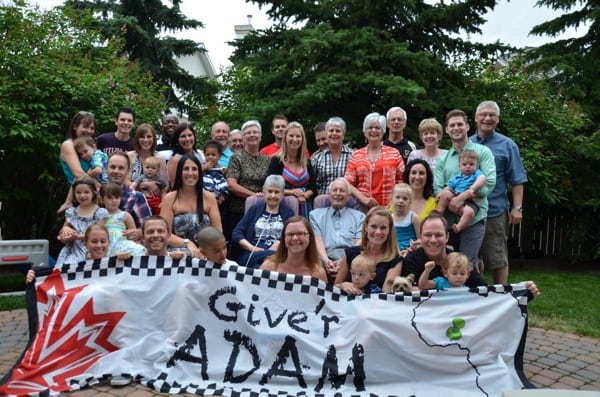Ultra spectator Wendy Swinton has been actively spectating since 1998 when her son Adam Campbell began competing as a triathlete. Wendy can be seen spectating at triathlons, 10k’s, and half and full marathons. She has also upped her skills and is now an ultra-spectating veteran of races ranging from 50k to 100-mile distances. Her first ultra-spectating experience was the Chuckanut 50k. She has worked hard to improve her skills with a rigorous and diverse schedule including hours researching races on the Internet and traveling to races far and wide. Look for Wendy in various spots along race courses laden with bells, whistles, signs, clappers, camera, and stopwatches. You can recognize her by her cheers and frantic animation. Wendy will always find her way to the finish, exhausted and spent, but giving it her all (even when her voice gives out). In this article, Wendy uses her wisdom and experience to pen her tips for ultra-spectating success.

Wendy Swinton gives some motherly support at Ironman Canada.
- Print out a copy of the race course to bring with you. Study the elevation gains, where the aid stations are/how far apart they are, and where you can find an access point to watch competitors pass.
- Find out the race-bib number of your athlete and what they are wearing so you can recognize them from a distance.
- Download and ‘follow’ all the race apps and websites on your phone including the race website, Twitter feeds, iRunFar, etc. Make sure your phone (and camera) is fully charged.
- Know your athlete and discuss with them ahead of time how long they expect each segment should take (on a good day), and where they hope to be positioned against their competitors. Know who their main rivals are as this will give you a good sense of how your athlete is doing as others race by (or follow behind).
- Dress for the elements. As much as your heart rate will rise along with your blood pressure, spectating will not heat you up (or cool you down), and there will be a lot of time spent anxiously waiting around in all sorts of weather conditions that can change as the day/night progresses. Bring binoculars.
- Now your training/prep work is done and you are ready to see your athlete off at the start, but give them their space. They are focusing, warming up, and getting race ready.
- After the race has started, get to the next viewing/cheering point as soon as you can. This could be an aid station or an isolated spot along the course where you know they will be given a boost by having someone there cheering them on. (Midway through a particularly difficult section would be ideal–but this may not be accessible to we mere mortals before the ultrarunner arrives.) Just make sure you don’t obstruct any racers or officials.
- Repeat #7 as often as possible throughout the race.
- If your athlete doesn’t show up when you expect them to, yes you have reason to be concerned, but there is nothing you can do about it. This could mean they’ve overestimated their speed and the course; they’ve hit a rough patch (and can recover); they’ve hit a rough patch (and are walking); or they’ve hit a rough patch and are being helped off the course. Another scenario could be that they’ve gone off course but are fine physically (likely not so fine mentally); or they were in a pack and you just missed them. They will show up eventually. If you have a phone, check the race Twitter feeds or find out from someone who was out on the course as a spectator if they’ve seen them. (Don’t ask a racer–that is not their focus.)
- Get to the finish line where there may or may not be parking. As you may have a long walk, put that into your timing to arrive on time to see your athlete complete their race.
- Emotions can be very raw at the finish line so be prepared for tears, wracking sobs, and pure joy. All of this can take place while the athlete is upright, walking wobbly legged, or even prone–flat out on the ground. (Make sure they aren’t obstructing other finishers as they cross the line.)
- After the race, they will want to debrief the race and the course as well as their their ups and downs with other racers. They’ll also want to congratulate the winner (or be the recipient of the congratulations), and get some calories into them and perhaps have a massage. So repeat #6–give them their space.
- Celebrate.
- Time for sleep, but remember that as exhausted as you are from screaming your lungs out, jumping up and down in excitement, and as ready as you are for bed, your ultrarunner will likely have a hard time shutting down and sleep will not come easily.

Adam Campbell’s family cheering squad.
Call for Comments (from Meghan)
- We’re hoping Wendy’s tips can be a jumping-off point for a fun discussion on ultra spectating. Are you an expert ultra spectator? If so, share with us your wisdom and tips for watching an ultramarathon.
- Have you spent time on both sides of the coin, both as a runner and as a spectator? If so, what have you learned as a runner that can apply to ultra spectating?
